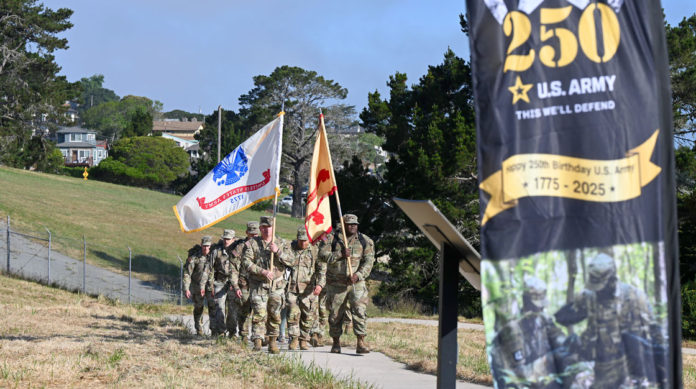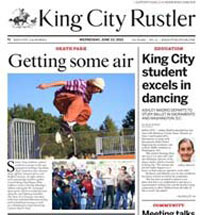
CENTRAL COAST — Almost 500 people, ranging from babies in strollers to the fit-and-trim servicemembers and those in their 70s, marched in the Army 250-Mile Ruck March from Camp Roberts in the Central Coast to the Parks Reserve Forces Training Area in the San Francisco Bay Area from May 7-11.
This was a historic, all-encompassing endeavor showcasing the Total Army might, and partnership with the civilian community.
“Our participants logged 250 miles, but what you don’t see is the honor of those 250 years of Army history, that is not just distance, that is legacy,” said the 63rd Readiness Division (RD) Commanding General, Maj. Gen. Tracy Smith, during the May 11 closing ceremony at Parks Reserve Forces Training Area (PRFTA) in Dublin.
Marchers braved the hot afternoon sun and the nighttime chills, dust devils and 30-mile headwinds. They also enjoyed the scenic country roads, stopped at landmarks and reflected on the military and Central Coast history. Servicemembers carried a ruck (backpack) with 25-35 pounds, but it was not a requirement for civilians. Participants also had the honor to carry the Army flag, along with a binder with names of fallen soldiers dating back to the Korean War throughout the journey.
“With every leg, every mile, every step, our participants carried more than the weight on their back, they carried the stories of those who came before us,” Smith said.
Community-Wide Celebration
This monumental achievement was hosted by the U.S. Army Garrison Fort Hunter Liggett (FHL) in partnership with three Army garrisons, the 63rd RD, many Army and Reserve Officer Training Corps units, U.S. Army Recruiting Command, five counties and 50-plus cities/towns, law enforcement agencies and community groups. And, let’s not forget the Gold Star families and public that walked with the soldiers or came out to cheer participants on.
“This isn’t just a Fort Hunter Liggett event — it’s a team effort,” said FHL Commander Col. Stephen Trotter. “It’s soldiers, garrisons and Army commands from across California coming together to make this happen while celebrating what makes the Army special: our people, our mission and our legacy.”
The mastermind of this monumental ruck march was the FHL Headquarters Company, the HHC Commander Maj. Eric Flanagan and First Sgt. Brandon Quinones. The team did an immense amount of coordination and endured many sleepless nights in planning this event, which included jumping in to cover legs that didn’t have enough people during the wee hours of the night. They also created the binder with names of fallen soldiers.
“It was the most unique experience! California is gorgeous and the route was gorgeous,” said Flanagan, who added that everyone he interacted with throughout the journey was highly motivated and excited to be part of the event. “Everyone motivated each other…especially at 2 o’clock in the morning when things get interesting.”
His wife, Marcela Flanagan, marched more than 60 miles during day and night legs along with her husband. “I wanted to learn and experience what soldiers like my husband goes through,” she said. “This was a forever experience.”
The event kicked off on May 7 at Camp Roberts, a National Guard installation in San Miguel.
“Today, we come together as a team. A team of teams to commemorate the U.S. Army’s 250th birthday,” said the Deputy Garrison Commander Lt. Col. David Hartshorn. “As a team, we are showing that we are Twice the Citizen that is always ready, always there and inspiring a nation to Be All You Can Be.”
“This 250th birthday is not just a celebration, it is a recommitment,” said Col. Dan Artino, commander of the U.S. Army Garrison Presidio of Monterey (POM) during the May 9 ceremony at the Sloat Monument in Lower Presidio Historic Park, marking the mid-way point of the ruck march. He added that this event is “not just a physical test of endurance — it’s a powerful symbol of dedication, resilience and unity. It is a recommitment to our Army values, a recommitment to our shared mission and a recommitment to each other.”
A soldier for life, retired Command Sgt. Maj. Garren Fulmer and his wife rode their motorcycles all the way from Las Vegas to participate. He even donned a World War II-era uniform to mark the 250 years of Army history.
“I was honored and humbled to march along the current generation of soldiers,” Fulmer said. “Col. Trotter and the other Army Reserve leaders understand this challenging endeavor builds strong soldiers.” Fulmer also marched as a representative from the Association of the U.S. Army (AUSA) Sixth region.
The overarching response from participants was immense camaraderie and making new friends. Master Sgt. Kimberlee Hilliard with the 351st Civil Affairs Command based at Moffett Field said, “I made so many new friends along this journey and I can’t even tell you how amazing that feels!”
Hilliard had been in the Army for 20 years and stated that this was one of the best experiences in her entire career. She clocked in the most miles — 80.44 — which included the most difficult “Ragnar” Legs through the Santa Cruz Mountains. She appreciated the time during the march to think about those that paid the ultimate sacrifice “because without them, we wouldn’t be here where we are today.”
“My journey was long and exhausting, but it was an incredibly exciting and fun journey,” Hilliard said. “There were lots of huffing and puffing, and camaraderie with my peers to my left and right keeping each other standing. The Santa Cruz Mountains were by far, the most rigorous, but the best 30 miles in the entire ruck march.”
Challenging Legs
The most challenging legs of the ruck march were two 15-mile sections through the Santa Cruz mountain range. They were conducted in a “Ragnar” style, a two-day and one-night stretch testing the soldiers and civilians’ endurance to the limit. Legs 33-38 started on May 9 at 10:30 p.m. and ended the following day at 4:30 a.m. with almost 2,000 feet elevations. Legs 47-49 started on May 10 at 4:30 a.m. and at 10:30 p.m. with almost 1,000 feet elevations.
Coming in a close second with most miles marched is FHL’s Staff Judge Advocate Maj. Bill Druffel, who’s been an Army Reserve soldier since 2008. He was the Officer-in-Charge of Legs 33-38 of the first Ragnar section (the most difficult part of the ruck march) and participated in the event because he “wanted the challenge.”
“I loved the idea of finding other rucking enthusiasts and sharing that load together and my teammates did not disappoint,” Druffel said.
He recounts the event as “a truly profound experience” and how he met someone new on each leg — fellow soldiers, airmen, veterans and civilians.
“It was such an honor to listen to retirees speak of their experience and then have the privilege of answering questions put to me by the ROTC Cadets,” Druffel said. “Every single person I encountered at every step of the way was so excited to be there. I know they lifted me up, and I can honestly say I never felt tired when we were moving and talking.”
Marching with Druffel was one of the youngest participants, 14-year-old Elijah Painter, who joined his father Col. Paul Painter with the 63rd RD during the first Ragnar stretch.
“He was an inspiration to us all,” Druffel said. “He carried weight, even though he didn’t have to, and did not rest until we did more than 12 miles during the arduous 2,000-feet climb up the mountain.”
The Painters signed up for the Ragnar legs because they “knew there would be plenty of volunteers on the less challenging sections and it would be more meaningful to do the ruck through the woods rather than on a sidewalk or roadside trail.” Their biggest takeaway was “The camaraderie. We all volunteered to challenge ourselves and be part of something that we will look back on with pride and say I did that,” said Paul Painter.
Honoring the Army’s Legacy
Among the most seasoned participants were Army Reserve Ambassador Phil Stage and Doug Miller, a member of the AUSA Maj. Gen. Dean Chapter. Both gentlemen were part of the leg 50 marching into PRFTA. AUSA MG Dean chapter provided refreshments during the closing ceremony. AUSA MSG Petry Chapter provided snacks and water for ruck march participants.
“I’ve spent over half my life associated with the Army, so it’s a family thing to celebrate this milestone birthday,” Stage said.
“It was a wonderful experience,” added Miller. “I probably talked to everyone in the group, and we got a lot of high fives from people along the way.” Miller is a retired major who served two tours in the Vietnam War as an Army helicopter pilot.
Bradley resident Shawnee Giles, also in her 70s, marched 10 miles in the Bradley and Jolon legs (borders FHL) in honor of her husband, who was a Vietnam War veteran.
“I loved seeing the countryside on the base that I never get to see,” Giles said. “I belong to the Barbwire Club of California and saw some very old wire on the hike and some fascinating rocks with shells imbedded in them. I would love to be a part of something like this again in the future.”
Civilian Aide to the Secretary of the Army (CASA) Jeffrey Hamel said, “It was a great showing of community, from general officers, ROTC cadets and servicemembers past and present — thank you to all who made this great event come together.” CASAs play a critical role in maintaining the Army’s relationships with communities across the nation.
“It was such an honor for us to be part of this momentous occasion celebrating the Army’s 250th birthday. Even though our son Aaron was KIA, we will forever feel like the Army is our family,” said Gold Star Parent Richard Fletcher.
There were many other dignitaries like mayors and Army generals who participated in the ruck march and the ceremonies conducted at FHL, POM, Moffett Field and PRFTA. In addition, servicemembers past and present from other branches of the military joined forces for this epic challenge.
Staff Sgt. Daniel Sielicki with the Air National Guard 129th Rescue Wing based at Moffet Field, was another marcher in the Ragnar Legs 33-38. He prepared weeks prior with friends hiking the uphill portion of the Legs with the same pack-weight and footwear during the actual event. He took on the challenge because he just “enjoys the physical difficulty and the associated logistical challenges of carrying weight over challenging miles.” Having friends marching along was another reason for signing up for this event.
It was a very somber experience for Ron Raade, a Marine Corps and Army Reserve veteran, and Army Civilian working at FHL. He participated in Legs 9 and 16 to remember “friends who were in the binder and to think about them.” The 62-year-old added that the marching also reminded him that, “I was old, and Leg 16 told me I’m old!”
“It was bittersweet to see it end. The thing that I will miss the most is the camaraderie…it was walking side-by-side with servicemembers of all branches and civilians…just having a good time. Nobody got paid to do this, no one got promotion points,” said First Sgt. Quinones.
Epic Journey Complete
More than 60 support staff from all the garrisons worked together for months to plan this event. Emergency Medical Teams from FHL and PRFTA trailed the ruck march participants through the entire 250 miles. San Luis Obispo, Monterey, Santa Cruz, Alameda and Santa Clara law enforcement also provided escorts when needed in busy urban areas. The National Parks Service also provided support at the Fort Ord Monument. Army Reserve bands also provided the music at several of the ceremonies marking the flag hand-off from the commanders.
The Army 250-Mile Ruck March ended at PRFTA on May 11.
“To my brothers and sisters in arms, there is no one I’d rather serve with than each of you. To the veterans, I see you…wear your badges of honor with your heads held high. To our families, none of this is possible without you. To the next generation of soldiers, let no one tell you can’t do it or you’re not good enough. To our enemies, we are prepared to fight and win, anytime, anywhere,” said the PRFTA Commander Lt. Col. Richard King.
In addition to celebrating the Army’s birthday, he acknowledged Mother’s Day and expressed gratitude to all the mothers present for spending their special day with the Army family.
“As we continue to celebrate the Army’s birthday on June 14, I’d ask you all to remember the Army families,” said FHL Commander Col. Trotter. “They are the unsung heroes of the Army’s 250-year legacy — our families — who have been there alongside us, missing us when we’re deployed, supporting us, praying for us, and sometimes, burying us. There have been many that quietly support us who do not get any limelight. They are the ones that keep the family together and take care of everything while we are deployed or unable to be there.”
Footage from the Army 250-Mile Ruck March is at each installation’s social media pages: dvidshub.net/feature/Army250RuckMarch.














